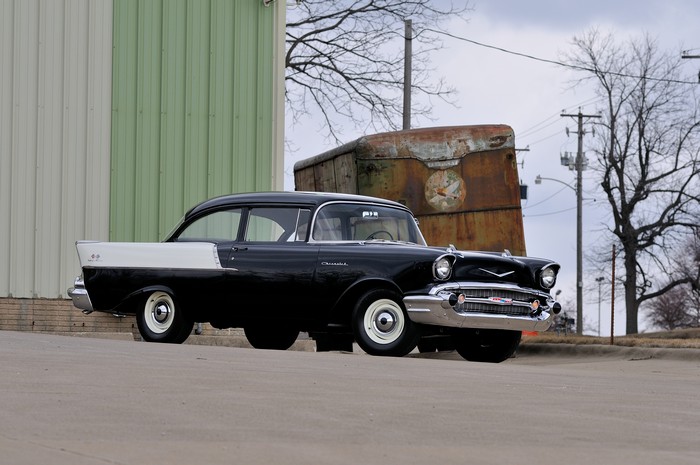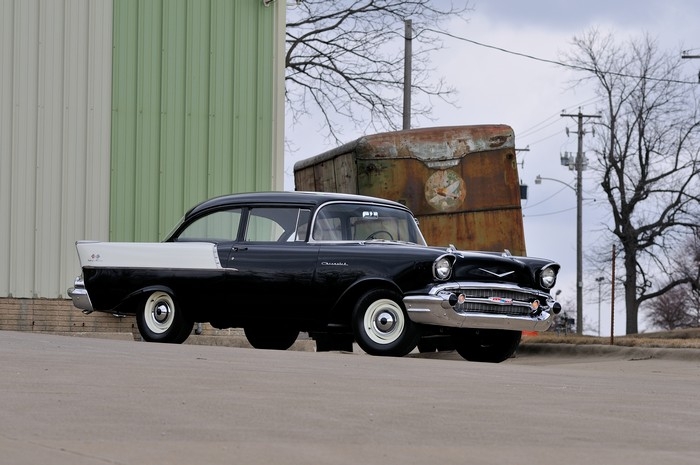
• 1957 Chevy 150 sedan “Black Widow”
• Built to re-create the famous Black Widow car from 1957 with one very important modern upgrade, a new GM performance parts Ram Jet 350 fuel-injected engine, dressed to look just like an original Rochester fuel-injected engine
• Correct 4-speed manual
• 3.50 Posi rear end
• Correct Sun tach
• Frame-off, no-expense-spared restoration
SCM Analysis
Detailing
| Vehicle: | 1957 Chevrolet 150 Black Widow Replica |
| Years Produced: | 1957 |
| Number Produced: | Approximately 10 |
| Original List Price: | Approximately $3,000 |
| SCM Valuation: | $55,000–$110,000 (museum-quality replica) |
| Tune Up Cost: | $275 |
| Distributor Caps: | $31 |
| Chassis Number Location: | Plate on the left front door hinge pillar |
| Engine Number Location: | Pad on front of block below right cylinder head |
| Club Info: | Tri Chevy Association |
| Website: | trichevy.org |
| Alternatives: | 1957 Ford Fairlane F-code, 1957 Dodge D-500, 1957 Plymouth Fury |
| Investment Grade: | B |
This 1957 Chevrolet 150 sedan, Lot S90.1, sold for $50,825, including buyer’s premium, at Mecum’s Houston auction on April 6, 2013.
Has an American performance car ever had a more sinister name? Chevrolet never officially called these 1957 racing sedans “Black Widows” — in fact, the cars didn’t officially exist. But that just adds to their mystique. They were very real — just ask the competition.
The man behind the Black Widow project was Vince Piggins, who had made the 1951–54 Hudson Hornets dominant in stock-car racing before moving to General Motors in 1956. With a mission to make Chevrolet a force in racing, Piggins set up the Southern Engineering and Development Company (SEDCO) in Atlanta. Piggins had the support of legendary Chevrolet personnel such as Zora Arkus-Duntov, John Dolza and Ed Cole as he set about creating a race-spec Chevrolet sedan for the 1957 season.
It’s ironic that today’s “stock cars “ don’t have one component from a production automobile. Back in the ‘50s, except for a simple roll bar and seat belts, every piece of that “stock car “ had to be issued from the manufacturer. So every one of the special components that made the Black Widows so fast had a factory-issued part number.
Not your average Chevy
Piggins built approximately 10 Black Widows, plus two development cars. All were based on Chevrolet 150 Model 1512 utility sedans (business coupes) built at the Lansing plant — the basest of the base models. The engines were the famed 283-hp, 283-ci fuel-injected units that Duntov and Dolza had developed primarily for the Corvette.
Every Black Widow featured black-and-white two-tone paint, and underneath that humble skin were numerous special parts, such as six-inch-wide, six-bolt wheels and a 10-bolt rear axle that were similar (but not identical) to those found on Chevy half-ton trucks. Even the fuel tanks on these cars were larger 20-gallon items, taking up what was originally the spare-tire well.
Records, rules and legends
The Black Widows were ready for the famous Daytona Speed Weeks in February 1957, where their speed became the stuff of legend. Buck Baker ran away with the Grand National race on the oval beach-and-road course and on the beach in Class 5 (259- to 305-ci), Chevys took 33 out of 37 places in the Flying Mile. It was a stunning performance, so much so that NASCAR set down new rules on February 20, 1957, mandating just one 4-barrel carburetor. It was the end of fuel-injected, supercharged, and multi-carb stock cars, and it’s a rule that still stands today.
But not every racing ’57 Chevy was a SEDCO Black Widow. SEDCO published a catalog called the “1957 Stock Car Competition Guide,” filled with the list of factory racing components and detailed instructions on how they created the Black Widows. The Competition Guide was sent to 411 dealerships on April 19, 1957, in an effort to persuade racers to build their own Black Widow copies, with all parts available from their local dealers. So while only the SEDCO-built cars should be considered Black Widows, many other ’57 sedans and business coupes were converted into Black Widow clones for stock-car and drag racing.
With Congress threatening to force auto manufacturers out of racing, GM signed the Automobile Manufacturers Association anti-racing pledge in May 1957. On June 9, Chevrolet President Ed Cole ordered SEDCO to shut down. Even without fuel-injection or the support of SEDCO, Chevrolets won 22 NASCAR Grand National races that year, and Buck Baker took the championship.
Rarities and replicas
Two SEDCO-built Black Widows are thought to exist today. Beyond that, verifying any purported Black Widow or circa 1957 Black Widow clone will be very difficult. They were all built by third parties, not Chevrolet, so no records exist.
A number of Black Widow “replicas” or “tributes” have been created over the past few years. Some are nothing more than ’57 Chevys painted black and white. Others are heavily modified ’57s with modern equipment that have little in common with the real Black Widows, save the distinctive paint scheme. But a few true replicas have been crafted, following the Stock Car Competition Guide to a tee.
These painstaking re-creations are the pinnacle of replicas, and are true museum pieces. One of these sold at Barrett-Jackson’s Scottsdale auction in January 2010 for $100,800, while a superb reproduction of Buck Baker’s car sold for $57,200 at Barrett-Jackson’s Las Vegas event in September that same year.
A modern spin on the old racer
Our feature Black Widow, however, is a tribute with a twist. From the outside it has the right vintage look (although it’s missing the open six-bolt wheels). Inside, it has the correct bench seat and Sun tachometer, but also a floor-shift 4-speed manual (the real cars were 3-on-the-tree manuals) along with armrests, sun visors, and a few other comforts the real Widows lacked.
This car’s big upgrade is under the hood. What looks like a correct ’57 283 Fuelie is really a modern crate engine: GM’s Ram Jet 350 with iron Vortec heads. It features advanced electronically controlled port fuel injection that makes 350 hp in stock form. Here, it’s been styled to look like one of the old Rochester mechanical systems, so at first glance, everything looks vintage under the hood. It’s close enough to fool most passers-by.
My late friend and mentor, Paul Zazarine, coined the term “restification,” meaning the hybrid of accurate restoration and hidden updates. This car is a fine example of restification — more accurate than many “tributes,” yet more reliable and enjoyable to drive than the museum-quality replicas. In short, this car had all the looks as well as modern drivability. Just hit the key and head out to your favorite car show. No fussy mechanical injection gremlins, and no worrying about hurting a vintage piece by putting real miles on it.
We’ve seen similar replicas sell for around this same price, but those replicas lacked much of the vintage vibe of this Black Widow, including the stylized Ram Jet crate engine. So even though it isn’t a 100% correct Black Widow copy, it’s a really usable one. And at this price, that makes this fast, fun Chevy a really great buy.
(Introductory description courtesy of Mecum Auctions.)
